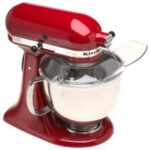About three months ago my favorite trusty blender mixed its last frozen drink before shuddering, coughing once and giving up the ghost. After almost thirteen years of pool parties, late-night bashes and the occasional milkshake, we said a eulogy and gave it the proper burial it so well deserved. Then came the big question and the source of much consternation between my wife and me: what blender should we buy now? Having been a fan of the Cuisinart name myself, the answer seemed obvious to me; little did I know, my wife felt the same way about KitchenAid appliances. Rather than arguing about it (which inevitable ends up with one of us on the couch-and you can guess which one) we decided to buy one from each brand, keep the one we liked and give the other one away. That in mind, we purchased the KitchenAid KSB5 Ultra Power 5-Speed Blender and the Cuisinart CBT-500 SmartPower Premier 2-Speed Blender. After using each for a week, we came to some surprising conclusions.
1. Price
Both blenders are in roughly the same price range: we bought the KitchenAid KSB5 for $100.00 and the Cuisinart CBT-500 for $89.99. We figured two blenders in the same price range would mean they both have the same quality, which is why we were greatly surprised by the disparity between the two brands when we tried them out. Still, judging by price alone the Cuisinart blender beats out its KitchenAid counterpart by a slim margin. But don’t stop here; I urge you to read the next category, because when it comes to kitchen appliances, price doesn’t always mean everything.
2. Features
I was mildly surprised to see that the Cuisinart blender had only two speeds when it costs almost as much as KitchenAid’s 5-speed blender. The KitchenAid KSB5 surprised me in other ways, too: its heavy glass jar (holds 40 ounces) and the weight of its base make it a sturdy countertop appliance, and its pour spout is wider than usual to easily handle thicker substances like milkshakes and margaritas. The thicker glass of the jar also makes it more difficult to break, a feature I made sure to test a few days after the purchase (strictly for research purposes, of course.) The blades cut through ice as easily as through butter, making mixed drinks as easy as adding the ingredients, pressing a button and enjoying the results; cottage cheese and salad dressings are even faster. I wasn’t crazy about the meager 1-year warranty, but so far the KSB5 seems so well made it doesn’t even need the warranty. Contrast this with Cuisinart’s CBT-500 SmartPower, which comes with a 3-year warranty and could use every bit of it. On the plus side, it offers a 600 watt power supply and a larger capacity jar (it holds 50 ounces) than the KitchenAid KSB5. Unfortunately, even I concede that it falls woefully short in other categories: its glass jar is thinner and more fragile, and the material looks like it’s higher quality than it really is (for example, some parts of its blade base are plastic and rubber where other blenders have an all-metal base.) It looks good on my counter, and maybe that’s why I originally thought it would outperform its KitchenAid opponent. While its two speeds performed decently, it wasn’t as handy as five speeds for someone like me, who can always find a use for each speed. While the Cuisinart CBT-500 is superior to blenders with plastic jars, it fades into the background when faced off against the sturdy, more durable KitchenAid KSB5.
I chalk it up to just another instance of my wife being right, but sometimes even a reliable brand name like Cuisinart can fall short. Even though they’re in the same price range, the KitchenAid KSB5 Ultra Power 5-Speed Blender beats out the Cuisinart CBT-500 SmartPower Premier 2-Speed Blender by far. At least now I won’t have to sleep on the couch.




